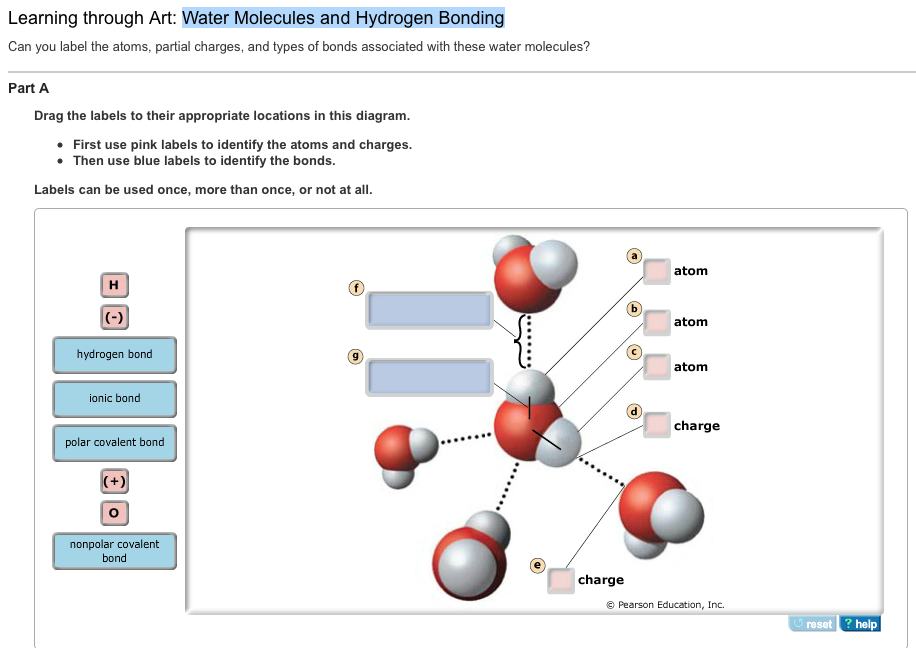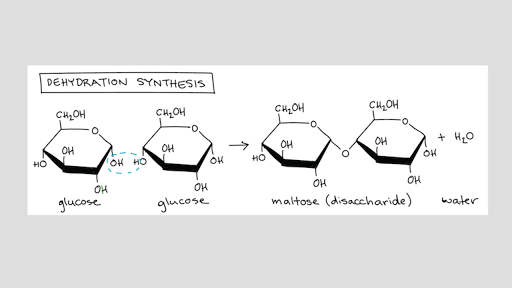39 drag the labels to their appropriate locations on the diagram of the water molecules below
Answered: DRAW IT Draw the hydration shells that… | bartleby Below is a diagram illustrating electron shells around a chloride ion. Keeping in mind that chloride has an atomic number of 17, drag the appropriate number of electrons to each electron shell to create a Cl-1 ion. Labels can be used more than once. arrow_forward Sucrose, C 12 H 22 O 11 , is table sugar or cane sugar. Solved Part A - Hydrogen bonding Label the following diagram | Chegg.com Question: Part A - Hydrogen bonding Label the following diagram of water molecules indicating the location of bonds and the partial charges on the atoms Drag the labels to their appropriate locations on the diagram of the water molecules below. Labels can be used once, more than once, or not at all.
B12D | Biology Quiz - Quizizz 7 Questions Show answers. Question 1. SURVEY. 30 seconds. Report an issue. Q. The carbon cycle includes processes that release carbon into the atmosphere and places that act as carbon reservoirs. The diagram below shows both major processes that release carbon and major carbon reservoirs. Which of these disruptions would cause an excess output ...

Drag the labels to their appropriate locations on the diagram of the water molecules below
PDF MO Diagrams for Diatomic Molecules - Department of Chemistry Summary MO Theory • LCAO-MO Theory is a simple method for predicting the approximate electronic structure of molecules. • Atomic orbitals must have the proper symmetry and energy to interact and form molecular orbitals. • Photoelectron spectroscopy provides useful information on the energies of atomic orbitals. • Next we'll see that symmetry will help us treat larger molecules in Labeled Diagram of the Human Kidney - Bodytomy Size of an adult kidney: Length: 11-12 cm. Width: 5.0-7.5 cm. Weight of an adult kidney: Males: 125-170 g. Females: 115-155 g. Located in the abdominal cavity, kidneys are the most efficient filters. They are an important component of the human excretory system, and help the body retain essential molecules and get rid of the unwanted ones. Chpt. 1, 3, 24, and 9 HW - Weebly The output shuts off the original stimulus or reduces its intensity 3. Drag the appropriate labels to their respective targets. (starting with top half to bottom half) (from left to right) Stimulus, Receptors, control centers, effectors, balance (from right to left) receptors, control center, effectors 4.
Drag the labels to their appropriate locations on the diagram of the water molecules below. mastering biology online assignment chapter 3 Flashcards - Quizlet Drag the labels to their appropriate locations on the diagram of the water molecules below. Labels can be used once, more than once, or not at all. Classify each statement as an example of adhesion, cohesion, or surface tension. Drag each statement to the appropriate bin. adhesion: -Water molecules cling to the side of a beaker. Answered: Drag the labels to their appropriate… | bartleby Question Transcribed Image Text: Drag the labels to their appropriate locations on the diagram of the water molecules below. Labels can be used once, more than once, or not at all. • View Available Hint (s) Reset Help Group 2 H Group 1 8+ H Group 1 8- H Group 2 hydrogen bond Group 1 Group 2 covalent H bond ionic bond Group 2 Group 1 H H 9) What is the geometry around each of the three central atoms in the CH ... Explanation: We must first draw the Lewis structure of acetic acid. (Adapted from Chemistry@TutorVista.com) Carbon 1 This atom has four atoms directly attached and no lone pairs. Its electron geometry and its molecular geometry are both tetrahedral as in methane. Carbon 2 This atom has three atoms directly attached and no lone pairs. Phase Diagrams - Phases of Matter and Phase Transitions A phase diagram is a graphical representation of pressure and temperature of a material. Phase diagrams show the state of matter at a given pressure and temperature. They show the boundaries between phases and the processes that occur when the pressure and/or temperature is changed to cross these boundaries.
Drag the labels to their appropriate locations on the diagram of the ... Drag the labels to their appropriate locations on the diagram of the water molecules below. Labels can be used once, more than once, or not at all. Hint 1. Electronegativity and polar covalent bonds In covalent bonds, the electrons are not always shared equally between the atoms. Some atoms hold electrons more tightly than others. A Labelled Diagram Of Mitochondria with Detailed Explanation Mitochondria are a double-membrane-bound cell organelle found in most eukaryotic organisms. In all living cells, these cell organelles are found freely floating within the cytoplasm of the cell. The diagram of Mitochondria is useful for both Class 10 and 12. Drag the appropriate labels about the three water phases to their ... The three water phases: solid (ice) , Liquid (water), Gas (vapor) 1) The state of matter in which water is densest - Liquid 2) The state of matter in which molecules are most energetic - Gas 3) The state of matter of steam rising from a hot cup of coffee - Gas 4) The state of matter in which water molecules vibrate about fixed location - solid Labeling, ranking, sorting, or sentence completion questions Drag labels onto the provided image. Sometimes a label can be used more than once, or it may not be used at all for the correct answer. When you're satisfied with your answer, select Submit.. If you can't drag one or more labels to an incorrect target, try to position the label on another target.. To clear all your labels you've placed, select Reset (next to Help).
7.3 Lewis Symbols and Structures - Chemistry Let us determine the Lewis structures of SiH 4, CHO 2 −, NO +, and OF 2 as examples in following this procedure: Determine the total number of valence (outer shell) electrons in the molecule or ion. For a molecule, we add the number of valence electrons on each atom in the molecule: SiH4 Si: 4 valence electrons/atom×1 atom = 4 + H: 1 valence ... Water molecules and their interaction with salt - USGS Water molecules pull the sodium and chloride ions apart, breaking the ionic bond that held them together. After the salt compounds are pulled apart, the sodium and chloride atoms are surrounded by water molecules, as this diagram shows. Once this happens, the salt is dissolved, resulting in a homogeneous solution. [Answered] Drag the labels to the appropriate locations on this diagram ... Biology College answered • expert verified Drag the labels to the appropriate locations on this diagram. Use blue labels/targets to identify the organelles. Use gray labels/targets to identify the processes. Use pink labels/targets to identify the inputs and outputs. Not all labels will be used. Expert-verified answer JoiePatel Answer: Flash Cards: Isotonic, Hypertonic, and Hypotonic Solutions - Quia The greatest concentration of water is outside the cell. Therefore, water enters the cell and fills the central vacuole, causing the contents of the plant cell to press against the cell wall. The plant cell swells and stiffens as turgor pressure increases. What is the percentage of water molecules in distilled water? 100%
Bio 180 Chap 3 Flashcards - Quizlet Label the following diagram of water molecules, indicating the location of bonds and the partial charges on the atoms. Drag the labels to their appropriate locations on the diagram of the water molecules below. Labels can be used once, more than once, or not at all. a. covalent bond b. - c. hydrogen bond d. + e. + f. covalent bond g. -
Drag the labels from the left to their correct locations First, drag blue labels onto blue targets only to identify each stage of the life cycle. Next, drag pink labels onto pink targets only to identify the process by which each stage occurs. Then, drag white labels onto white targets only to identify the ploidy level at each stage. Labels can be used once, more than once, or not at all.
A Diagram Of Water Cycle with Detailed Explanations - BYJUS Below is a well labelled and easy diagram of water cycle for your better understanding. Diagram Of Water Cycle Stages of Water Cycle The complete water cycle is carried into four stages which are as follows: Evaporation, Condensation, Precipitation and Collection. Evaporation This is the initial stage of the water cycle.
Solved Label the following diagram of water molecules, - Chegg Transcribed image text: Label the following diagram of water molecules, indicating the location of bonds and the partial charges on the atoms Drag the labels to their appropriate locations on the diagram of the water molecules below.
The Structure of an Atom Explained With a Labeled Diagram Basic Diagram of an Atom. Most of an atom is just empty space and consists of a positively charged nucleus of protons and neutrons surrounded by a cloud of negatively charged electrons. The center of an atom is the nucleus and one or more electrons surrounding the nucleus. When one says an atom is electrically neutral, it means that the number ...
Structure Of Water Molecule | Properties Of Water (2022) - Botnam The structure of water molecule is made up of one molecule of oxygen and two molecules of hydrogen-bonded covalently. Water (H2O) is essentially considered one of the most important substances found on the earth. It covers over 70% of the earth's surface and makes up as much as 95% of the living organisms. The Structure of Water Molecule




Post a Comment for "39 drag the labels to their appropriate locations on the diagram of the water molecules below"